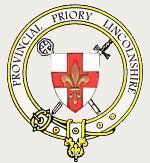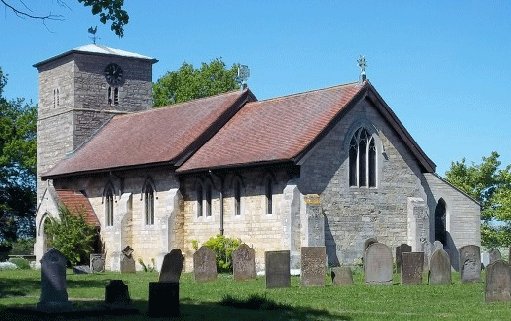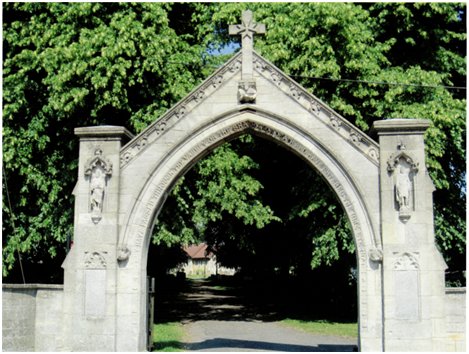




There have been at least three churches standing on this site, prior to the one here today. Apart from the tower, this church was rebuilt by J.T. Lee of London in 1903-4. The inscribed foundation stone is in the east wall.
Before that, the main body of the church was in such a state of disrepair that no single item of the building or furniture could be used again, so all but the tower had to be demolished. The Order of Saint John of Jerusalem contributed £50 towards the rebuilding of the church and King George V (then Prince of Wales,) as Grand Prior of the Order, gave £10. More than £2,000 was raised to provide a worthy building.
The Tower dates back to Norman times and extensive repairs to the outside were accomplished in 1924 at a cost of £168. There is reference to a sun dial in the west wall of the tower; marked 'Dial made in 1734.'
The Porch was added in 1910 at a cost of £75.
There is a Mass Clock or Scratch Dial on either side of the porch, the one on the right being the most visible.
On the roof of the church over the chancel is placed a Maltese Cross, with the Lion and Unicorn denoting the English branch of the Order of Saint John of Jerusalem. The Maltese Cross of the Order of St. John with its four arms represents the cross on which Jesus suffered while the eight points symbolise the Beatitudes given on the Sermon on the Mount (Matthew 5:3-10) . On the nave is a very uncommon type of cross, sometimes called the Jerusalem Cross. It is really the coat-of-arms of the Latin Kingdom of Jerusalem. There are four small crosses in the four corners of a large cross with gold crosses on a silver ground. They are said to represent the five wounds of Christ.
The Clock was formerly in St. Mark's Church, Lincoln.
The Vestry and Electric Heating were dedicated by the Bishop of Lincoln on May 23rd, 1954, the fiftieth anniversary of the opening of the new church building. The heating has since been changed to oil. In the summer of 2001 a new, larger Vestry was built, donated by a generous benefactor and was dedicated by Bishop Ronald Milner (retired) on October 12th, 2001.
After the new Vestry was built money was raised to re-tile the Roof of the Chancel and Nave in the spring of 2004.
The Kitchen and Toilet extension was built in 2013 from fundraising and donations and an official celebration was held where it was opened by the Venerable Tim Barker, Archdeacon of Lincoln on 21st July, 2013.
The Doorway and Door leading into the tower from the church were entirely renovated in 1927.
The Font is of the Norman period and probably in use long before the Templars came. But it has been sadly mutilated. Around the basin a miniature arcade of interlacing round arches has been cut down to within a few inches of the bowl. Some fragments of the top part are built into the walls of the church a few yards away.
There are also some Stones of undoubted antiquity with runic carving of Saxon work, which have formed part of a cross, either within or without the church walls.
There is a peal of Six Bells. The original five bells were restored and a new tenor bell added and dedicated on September 14th, 1946, to mark the end of World War Two.
The Coloured Shields affixed to the bosses and roof in the chancel represent the cross of the Order of Saint John (the Maltese Cross) and the victory of the Cross over the Crescent (the Moslem Device) in the Crusades. Of the medallions on the bosses in the nave, the purse represents 'The Charity For Poor Pilgrims,' and the lamb seated on a book, with the cross is the emblem of Saint John. They all were the generous gift of the Order of Saint John of Jerusalem.
The Pulpit and Choir Stalls were carved at the School of Carving under the direction of Rev. T.R. Seddon of Chelmarsh, Salop and were a gift from the Ladies of the Manor.
The Standard hanging in the chancel was left to the church by one of the Bailiffs of Eagle.
The Rood Screen was given in memory of Walter Baldock, former Schoolmaster of Eagle. He died 7th April, 1935.
The Organ was built by Cousans of Lincoln and dedicated on May 10th 1950. Due to a grant of £3,000 from the Foundation for Sport and the Arts and a donation from the Lord of the Manor, the organ was refurbished at the beginning of 1997 and was rededicated by the Archdeacon of Lincoln, the Venerable Arthur Hawes on 20th April, 1997.
The Registers date from 1588.

The Memorial Arch was erected in memory of eight men who lost their lives in the 1914-18 war and was unveiled by Lord Monson, Knight of Justice, on May 1st 1920. The two carved figures on either side of the Arch represent, on the left a Knight Templar, and on the right a Knight Hospitaller. The sculptor was Mr A.J. Tuttell of Lincoln. In 1985, following a special service in All Saint’s Church, Eagle, to celebrate the 75th Anniversary of the founding of the Province, each Preceptory was asked to donate £10 each to help fund the restoration of the two knights.
The avenue of Lime Trees was a gift and was planted in 1926.
The Knights Templar was an Order founded in 1118 by Baldwin the Second, King of Jerusalem, to protect and assist the poor pilgrims to the Holy Sepulchre. The connection with Eagle began when King Stephen (1135-1154) granted to the Templars the Manor of Eykel, to establish an infirmary for the sick of the Order and a home for aged members. The buildings were at Eagle Hall, chosen in preference to the Village because of its woods and fish ponds, so necessary to a half-monastic house. Henry the Second (1154-1189) granted to it the churches of Eagle, Swinderby and Skarle.
The Order of Saint John of Jerusalem, or Hospitallers was founded in Jerusalem in 1048 with a monastery, chapel and hospital for pilgrims and the sick, situated near the Holy Sepulchre. In 1323 what was left of the property of the Templars was transferred, under the Pope's order, to the Knights Hospitallers. Thus after some two hundred years in the possession of the Templars, Eagle passed to the Hospitallers who kept it for about the same length of time. The Preceptory of Eagle as the Templars called it, became the Commandery of the Hospitallers, ruled by the Grand Prior. The office of Bailiff of Eagle was one of the four Grand Crosses in England and ranked third in seniority of the Order, below the Grand Prior.
Eagle's Name. The Anglo Saxons settled in the area between 400 and 800 A.D., clearing the slopes of the oak trees, and ploughing and grazing the land. It is from this we have the origins of the name Eagle. It came from the Saxon Ac, meaning oak, and Leah, a clearing - hence Acleah, a clearing in the oak forest. Despite the efforts of the villagers the land outside of the village clearing remained inhospitable. The wolf still roamed the forests, the brown bear and wild cattle could be hunted in the Trent Valley. Wild boars grubbed for acorns amidst the oaks. There have been numerous ways of spelling Eagle throughout history before the spelling as we know it today. Probably the earliest noted record about Eagle is found in the Domesday Book, 1087, in which it is spelt in three different ways.
Most of this information is taken from 'Eagle, Lincolnshire, Ancient and Modern 1087-1932,' by Rev. W.D. Shepperd, M.A.